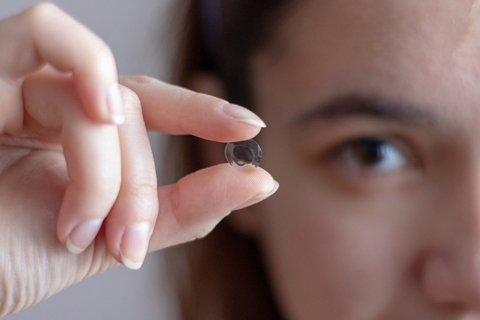
Orthokeratology, commonly called ortho-k, is a method used to correct myopia (nearsightedness) or astigmatism by wearing rigid gas permeable contact lenses overnight, so that no corrective lenses are needed during daytime hours.
Gas permeable (GP) lenses specialized for ortho-k are inserted at bedtime and worn as you sleep. Throughout the night, the lenses reshape your cornea gently so that your vision becomes clear on the following morning. The correction is temporary, and ideally no eyeglasses or contact lenses will be needed on the next day or two. In order to maintain sharp visual acuity on a daily basis, you need to wear the ortho-k reshaping lenses every night.
At present, three brands of orthokeratology contact lenses are approved for use by the FDA. Euclid Emerald, usually prescribed for myopia control, Paragon Vision Sciences, who produces “Corneal Refractive Therapy” (CRT), and Bausch and Lomb, who manufactures “Vision Shaping Treatment” (VST).
Candidates for Ortho-K
Ortho-k is very suitable for nearsighted people who are not appropriate candidates for vision correction surgery, such as children. Individuals of all ages with healthy eyes can try ortho-k, namely because it can be discontinued at any point without permanent effects to the eyes.
People who require vision correction and engage regularly in sports or work in extremely dusty, dirty environments will also appreciate the convenience of
ortho-k.
Vision Results from Orthokeratology
Success rates for ortho-k are generally higher for more mild vision prescriptions. The ideal goal is to provide 20/20 vision without any need for eyeglasses or contacts during the day.
According to FDA trials conducted on both CRT and VST lenses, more than 65% of ortho-k patients achieved 20/20 visual acuity. A whopping number of more than 90% of ortho-k patients achieved 20/40 vision or better (this is the legal requirement for driving without vision correction in most states). Consult with your eye doctor to find out if your vision prescription is within range for successful ortho-k treatment.
Note that although improvement in vision is generally reported within a day or two of wearing ortho-k overnight, the full effects may not be experienced until the lenses are worn for a few weeks. During this transition period, your vision will probably not be as crisp as it was with regular contacts or eyeglasses, and glare or halos around lights may be visible. Until ortho-k works fully, a temporary pair of eyeglasses may be required for specific actions, such as driving at night.
How Does Ortho-k Feel?
Although some people have trouble wearing regular gas permeable contact lenses during the day, ortho-k GP lenses are worn while sleeping – so discomfort and awareness of the lenses in your eyes is generally not an issue.
Is Ortho-k expensive?
Professional fitting for ortho-k requires a series of visits to your eye doctor. A number of pairs of contact lenses are also generally needed. GP lenses that are special for ortho-k are more costly than standard contacts. In sum, the fees for ortho-k add up to a higher total than regular contact lenses.
LASIK after Ortho-k
Some consider Ortho-K to be a non-surgical alternative to LASIK. Nonetheless, refractive surgeries, such as LASIK, are possible after treatment with ortho-k lenses. Yet because ortho-k works to reshape your cornea, you are required to stop wearing the lenses for approximately several months before undergoing LASIK. This allows your eyes to return to their original shape.
It’s important to inform your LASIK surgeon if you’ve been wearing ortho-k lenses, and you will be advised as to how long of a wait is necessary before having the laser procedure.
Information for Parents
CRT Is Very Safe For Children
Our office has used Corneal Refractive Therapy (CRT) to safely and effectively improve daytime vision in a number of children. Children place their CRT retainer lenses in at night before they sleep and remove them upon awakening. After a few weeks of wearing their CRT lenses, they obtain clear vision throughout the day. The retainer lenses must be inserted nightly to maintain clarity.
The number one concern parents have is safety. Euclid, the manufacturer of our CRT lenses, obtained FDA approved for all ages, there is no age restriction.
As some children grow their eyesight may deteriorate; there is nothing more disheartening to parents than seeing their children's prescription get worse year after year. We've found that nearsightedness does not progress as rapidly in children who wear CRT lenses.
Corneal Refractive Therapy (CRT): Not New
Corneal Refractive Therapy (CRT) is the term we use within our office for a technique generically referred to as Orthokeratology or Ortho-K. Previously, we used the term Gentle Vision Shaping System (GVSS) to describe this treatment. More recently, Euclid, the maker of our CRT lenses, refers to their method as Corneal Refractive Therapy. All of the terms refer to the use of a rigid lens to gently and safely reshape the front surface of the eye (cornea) to improve vision after the retainer lens is removed.
Reshaping the cornea with contact lenses to improve vision isn't new; some eye doctors have practiced it for decades. However, before FDA approval for overnight wear, the procedure had limited appeal. Now with safe, more oxygen permeable materials, the process has grown in effectiveness, safety and popularity.
